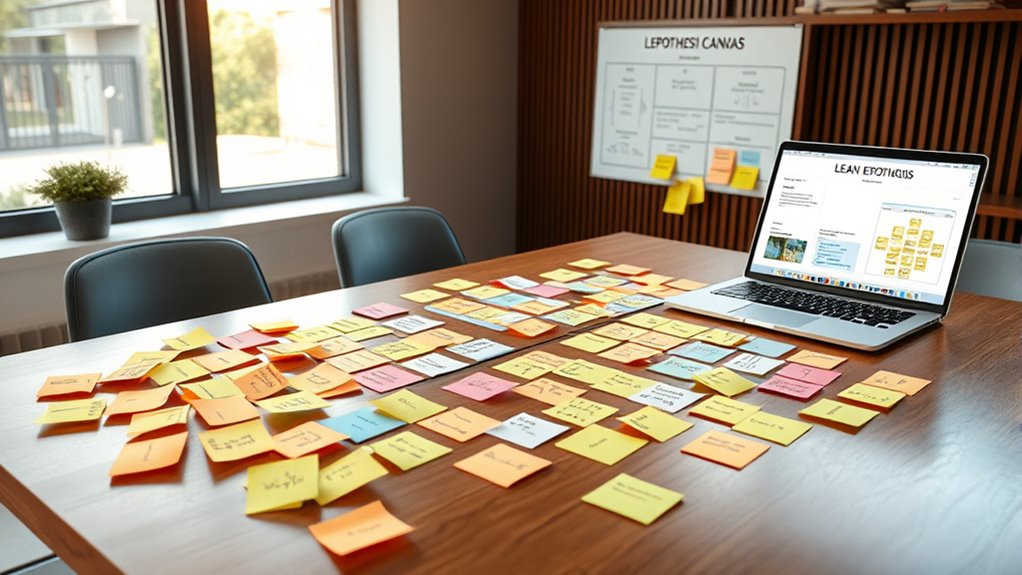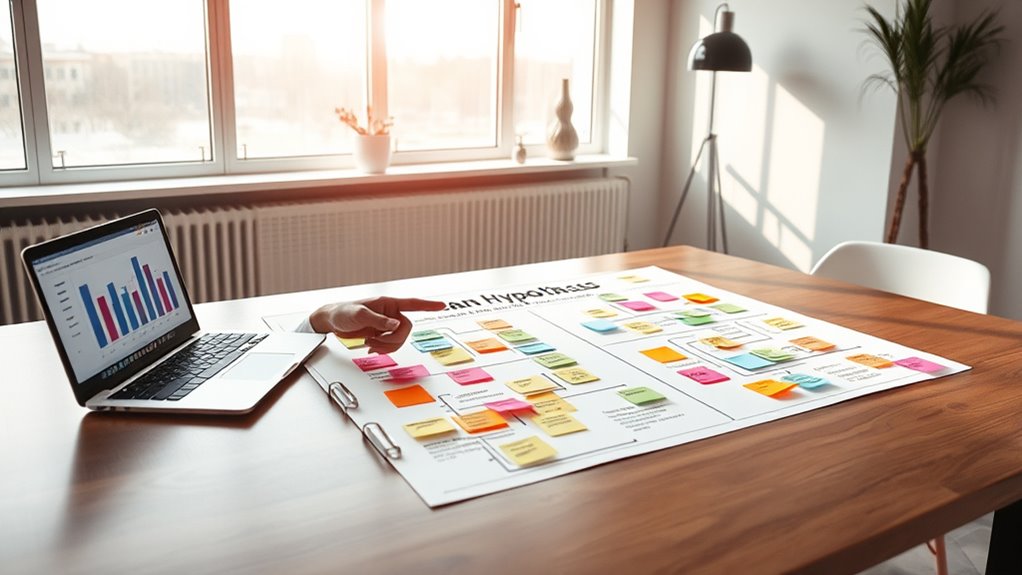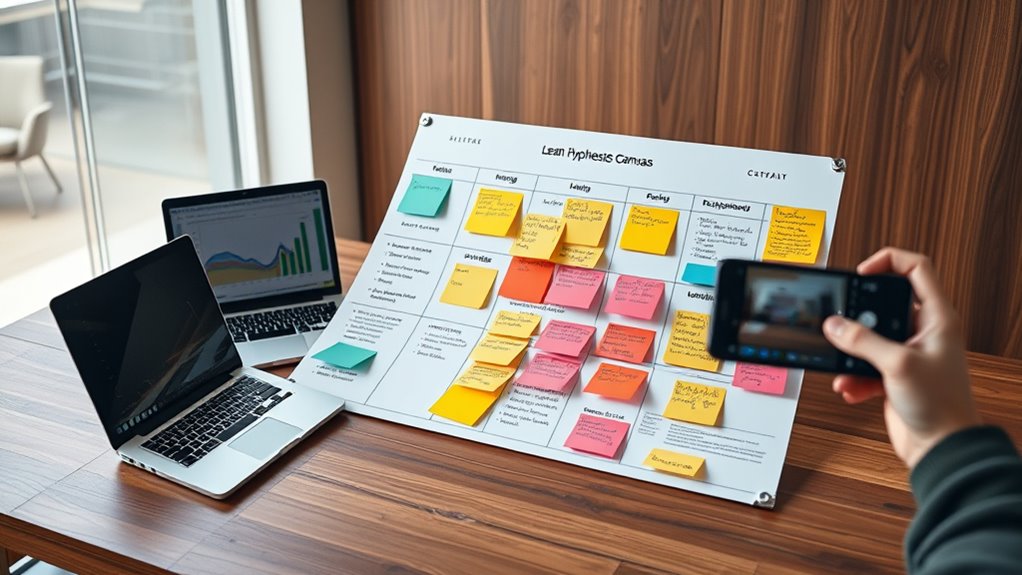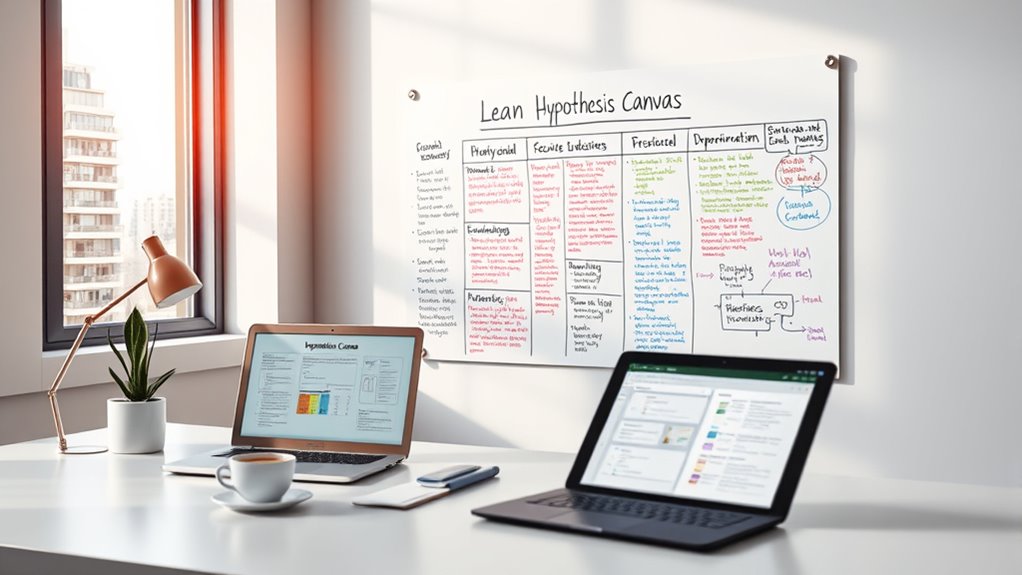The Lean Hypothesis Canvas helps you align your experiments directly with your core business value by systematically identifying and prioritizing assumptions that impact success. You focus on designing targeted, measurable tests that validate whether your solutions meet customer needs and support business growth. Tracking progress and adjusting based on real feedback guarantees continuous improvement. To maximize outcomes, integrating this approach into your innovation process keeps your efforts focused on high-impact areas—more insights await beyond this overview.
Key Takeaways
- Prioritize critical assumptions to ensure experiments target areas with the highest impact on business success.
- Design experiments that directly measure outcomes linked to key business metrics like revenue or retention.
- Use customer feedback and market data to validate assumptions and refine hypotheses effectively.
- Track and analyze experiment results against clear success metrics to assess alignment with business goals.
- Integrate the canvas into planning to maintain focus on hypotheses that drive real value and strategic learning.
Understanding the Core Components of the Lean Hypothesis Canvas

The Lean Hypothesis Canvas is a strategic tool that helps you clearly define and test your assumptions about a startup idea. Its core components include assumption mapping, where you identify and categorize your key beliefs about customers, problems, and solutions. This process guarantees you understand what needs validation first. Hypothesis prioritization then guides you to focus on the most critical assumptions that could impact your business’s success. By arranging these assumptions in order of importance, you can design targeted experiments that minimize risk. The canvas encourages a systematic approach, helping you avoid wasting resources on untested ideas. Additionally, understanding the Fokos platform can provide insights into content management and user engagement strategies. Overall, understanding these components gives you clarity on where to direct your efforts, ensuring your experiments are aligned with your business goals.
Connecting Experiments to Business Outcomes

How can you guarantee your experiments truly drive meaningful business results? The key is connecting your tests directly to desired outcomes. Use customer feedback to understand if your solutions meet real needs and adjust your hypotheses accordingly. Analyzing market trends helps you spot shifts that could impact your business, ensuring your experiments stay relevant. When you align experiments with specific metrics tied to revenue, retention, or engagement, you create clear pathways to value. Regularly reviewing customer insights and market data keeps you focused on outcomes rather than just ideas. Incorporating market data can also help you better understand external factors affecting your experiments. This approach ensures your experiments contribute to strategic goals, making your efforts more targeted and impactful. Ultimately, connecting experiments to business outcomes transforms hypotheses into tangible growth.
Designing Effective Tests to Validate Assumptions

To guarantee your experiments yield meaningful insights, focus on designing tests that effectively validate your assumptions. Start by identifying the critical assumptions behind your business idea. Use market research to gather data on customer needs, preferences, and behaviors, ensuring your tests are grounded in real insights. Incorporate customer feedback early to understand how your target audience perceives your value proposition. Design experiments that are simple, focused, and measurable—such as landing pages, prototypes, or surveys—that directly test your assumptions. Avoid overcomplicating tests; instead, aim for rapid, inexpensive validation. By aligning your tests with insights from market research and customer feedback, you increase the likelihood of making informed decisions that steer your business toward genuine value. Recognizing Relationship dynamics can also help tailor your approach to better understand your audience’s motivations and potential emotional triggers.
Tracking Progress and Measuring Success

Are you effectively tracking your progress to determine whether your experiments are moving you closer to your goals? Success metrics are essential for measuring the impact of your tests and ensuring your efforts align with business value. Use progress tracking to monitor key indicators that reflect whether your assumptions are validated or need adjustment. Regularly review these metrics to identify patterns and insights, helping you stay focused on what truly matters. By establishing clear success metrics upfront, you create a data-driven approach that minimizes guesswork. This process allows you to make informed decisions quickly, pivot when necessary, and maintain momentum toward your objectives. Effective progress tracking keeps your experimentation grounded and ensures each step brings you closer to validated learning. Incorporating relevant performance indicators related to user engagement and quality can further refine your approach and improve outcomes.
Integrating the Canvas Into Your Innovation Workflow

Seamlessly integrating the Lean Hypothesis Canvas into your innovation workflow can substantially enhance your ability to test ideas systematically. Start by mapping out user personas and aligning them with your market segmentation. This clarity helps you focus on specific customer needs and validates assumptions early. Incorporate the canvas into your regular planning sessions, using it to prioritize experiments that address critical uncertainties. By doing so, you create a feedback loop that continuously refines your understanding of your target audience. This integration ensures your team stays aligned on hypotheses that matter most, streamlines decision-making, and accelerates learning. Ultimately, embedding the canvas into your workflow transforms uncertainty into actionable insights, keeping your innovation efforts focused and aligned with real customer value. Additionally, considering vetted products and methods can help inform your experiments and ensure reliable results.
Frequently Asked Questions
How Does the Lean Hypothesis Canvas Differ From Traditional Business Models?
You notice that the lean hypothesis canvas differs from traditional business models because it focuses on hypothesis testing rather than fixed assumptions. Instead of creating a rigid plan upfront, you experiment with key parts of your business model to validate ideas quickly. This approach helps you adapt and pivot based on real evidence, ensuring your business aligns with customer needs and delivers value efficiently, reducing risk and increasing chances of success.
Can Small Startups Effectively Utilize the Lean Hypothesis Canvas?
You can definitely use the Lean Hypothesis Canvas to boost your startup’s scalability and customer validation. It helps you identify core assumptions, test them quickly, and adapt your approach based on real feedback. By focusing on experiments that align with business value, you reduce risks and better understand your customers. This iterative process is especially effective for small startups aiming to grow efficiently and validate their ideas early on.
What Common Mistakes Should Teams Avoid When Applying the Canvas?
Remember, “Pride comes before a fall.” When applying the canvas, avoid overconfidence bias that leads you to trust assumptions without validation. Neglecting customer feedback can derail your progress, so stay humble and listen actively. Make sure your experiments are aligned with real customer needs, not just your beliefs. Don’t jump to conclusions or skip validation—these mistakes hinder growth and waste resources. Stay grounded, test thoroughly, and learn continuously.
How Often Should Teams Revisit and Update Their Hypotheses?
You should revisit and update your hypotheses regularly, ideally every few weeks or after significant experiments. This guarantees continuous hypothesis iteration and keeps your team aligned with new insights. Frequent updates help you adapt quickly to market changes, customer feedback, or unexpected results. By maintaining an update frequency, you prevent stagnation and ensure your experiments stay relevant, ultimately guiding you toward more informed decisions and better business value.
Is There Software or Tools to Facilitate Using the Lean Hypothesis Canvas?
You can find digital tools and collaboration platforms that make using the Lean Hypothesis Canvas easier. These tools help you organize ideas, track experiments, and share updates with your team seamlessly. Platforms like Miro, Trello, or Notion offer templates and features tailored for lean startup practices. By leveraging these digital tools, you streamline your process, improve team collaboration, and guarantee your hypotheses stay aligned with evolving business priorities.
Conclusion
By mastering the Lean Hypothesis Canvas, you reveal the secret weapon to rapidly test ideas and align every experiment with massive business impact. When you connect experiments to real outcomes and track progress diligently, you’ll transform uncertainty into unstoppable momentum. Embrace this powerful tool, and watch your innovation efforts soar beyond even your wildest dreams—making your competitors wonder if you’ve cracked the code to unstoppable success!









